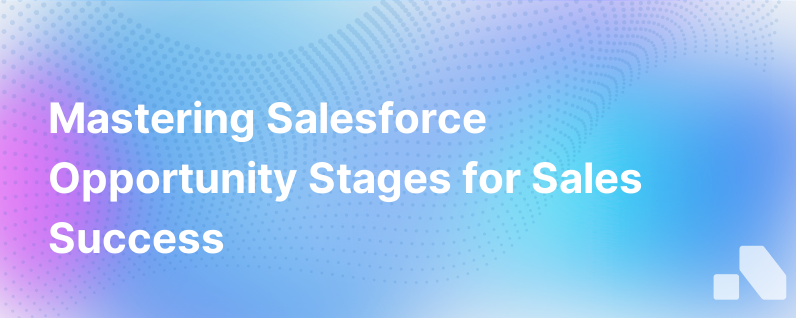
Navigating the sales pipeline is quintessential for Salesforce management within any business. Salesforce Opportunity Stages allow businesses to track the progression of a sale from the 'lead' stage right through to the 'closed deal', providing invaluable insights into the sales process. Understanding and customizing Opportunity Stages optimizes the sales workflow, aligns the sales team, and provides clearer forecasting for management.
In this deep dive, we explore the concept of Salesforce Opportunity Stages, how they work, why they are key to sales process optimization, and how to best customize them to reflect your unique sales process.
Comprehending Salesforce Opportunity Stages
Opportunity Stages in Salesforce represent the specific steps in your sales process that an opportunity — a potential revenue-generating event — moves through. These stages are generally depicted in a sequence that aligns with the buyer’s journey, allowing sales teams to track progression towards a sale.
The standard stages Salesforce provides are:
- Prospecting: Identifying potential buyers.
- Qualification: Determining whether prospects have a need for your product and the resources to purchase it.
- Needs Analysis: Assessing the customer’s specific requirements.
- Value Proposition: Crafting and presenting a proposal that outlines the value your product or service will bring to the customer.
- Decision Makers: Identifying and engaging with the individuals who have the authority to approve the sale.
- Perception Analysis: Gaining feedback on your value proposition and ensuring alignment between customer expectations and your offering.
- Proposal/Price Quote: Submitting a formal sales proposal or price quote to the customer.
- Negotiation/Review: Engaging in discussions around the final terms of the sale.
- Closed Won: Successfully completing a sale.
- Closed Lost: The opportunity did not result in a sale.
The Significance of Tailoring Opportunity Stages
The standard Opportunity Stages in Salesforce are a generic and can be a starting point. However, different industries and sales processes require a different sequence of steps that are more reflective of the typical buyer’s journey relevant to their market. The power of Salesforce lies in its customization – each stage must match the unique intricacies of your sales cycle.
Moreover, accurately defined stages help in streamlining the sales process as they set clear expectations for sales reps, allow for better forecasting, and help identify bottlenecks.
Optimizing Opportunity Stages for Workflow Precision
Optimizing sales stages requires a comprehensive understanding of your buyer’s journey and a close look at historical data. Here are some steps to follow:
- Understand the Customer Journey: Begin by mapping out each step your customers take from realizing they have a problem to purchasing a solution.
- Align with Sales Reps: Get input from your sales team about which stages align with their actual sales activities.
- Review Historical Data: Look at your historical sales data to see where deals are most often delayed or lost.
- Reflect on Qualification Criteria: Ensure each stage has clear criteria that must be met before moving to the next, reducing ambiguity.
- Customize Accordingly: Using the insights you gather, create custom Opportunity Stages that neatly align with your buyer's journey and sales strategy.
Implementing Custom Opportunity Stages
Once the preparation is done, you can customize Opportunity Stages in Salesforce by:
- Navigating to the ‘Opportunity Stages’ screen within the ‘Setup’ menu.
- Modifying existing stages or creating new ones to suit your process.
- Ensuring each stage is associated with the appropriate probability percentage, reflecting the likelihood of the deal closing at that particular stage.
- Setting clear definitions for moving opportunities between stages to ensure consistency across the sales team.
Remember, each stage should have actions and deliverables attached to it, ensuring that moving an opportunity to a new stage is an indication of tangible progress.
Continuous Monitoring and Iteration
Opportunity Stages should not be static. Continuous monitoring of how your stages are performing is critical. Periodically review your stage definitions and performances:
- Collect feedback from sales reps on the effectiveness and relevance of each stage.
- Analyze win-loss data to see if any stages predict deal outcomes.
- Make adjustments based on changes in customer behavior or company product offerings.
By taking an iterative approach, you ensure that your sales process evolves alongside your business and the market.
Standardization Across the Organization
To gain the most from Opportunity Stages, it's essential that everyone in the organization uses them in a consistent manner. Standardization:
- Ensures that forecasting is based on uniform criteria.
- Allows managers to compare performance and pinpoint issues across different teams.
- Provides a common language for discussing sales strategy.
Reporting and Analytics
Salesforce provides robust reporting and analytics tools that help businesses to understand and forecast sales trends based on their Opportunity Stages. Regularly reviewing reports and dashboards can provide actionable insights, such as:
- Which stages have the longest duration and may indicate roadblocks.
- Conversion rates across different stages.
- Performance comparison among sales reps or teams.
With these insights, leaders can make data-driven decisions about where to focus training and resources.
Conclusion
Salesforce Opportunity Stages are a powerful feature that, when customized and used effectively, provide a roadmap for your sales process, delivering clarity and consistency for sales teams and actionable insights for leadership. By regularly revisiting and refining your Opportunity Stages, you can ensure they remain an accurate reflection of your sales process, contributing to a well-oiled sales machine capable of predictive forecasting and efficient operations.
Understanding and utilizing the full potential of Salesforce Opportunity Stages is not just about optimizing Salesforce; it’s about optimizing your business’s pathway to revenue.